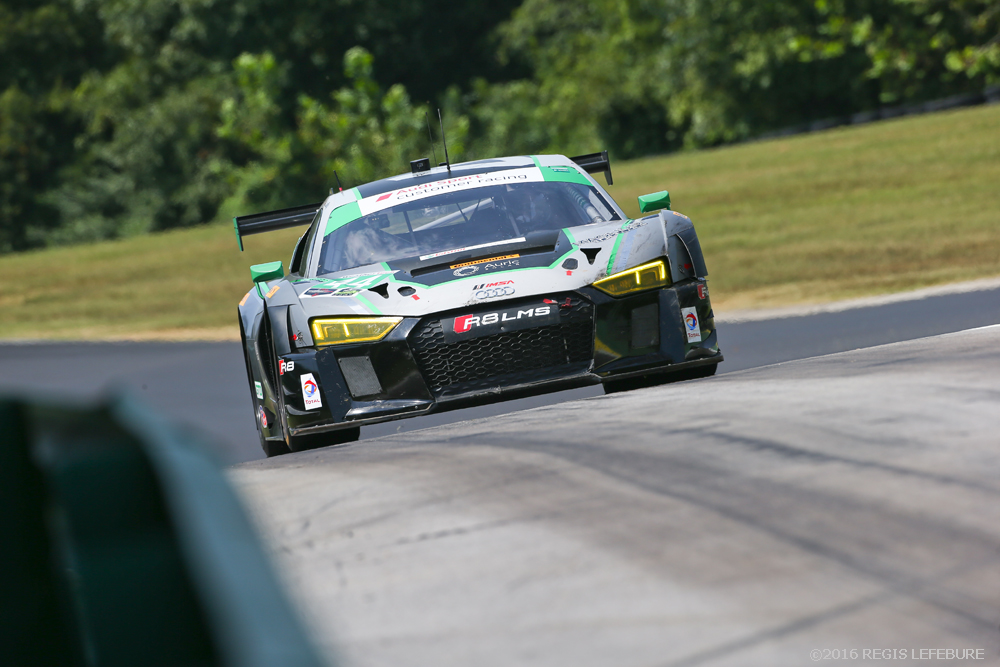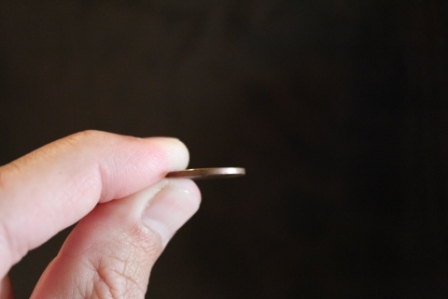REACTION: Magnus Racing Takes Third at VIR, Then Excluded by Series
 Friday, September 2, 2016 at 11:54AM
Friday, September 2, 2016 at 11:54AM 
SALT LAKE CITY, Utah (August 31, 2016)- Following a hard-fought race that saw the team advance seven positions during a nearly “all green” race, Magnus Racing’s recent third-place finish at the Michelin GT Challenge, the ninth round of the IMSA WeatherTech SportsCar Championship, has been completely excluded at the discretion of series officials due to a ride height infraction.
This is a highly contested point by the team, as they were able to clearly demonstrate on-track incidents led to the infraction. The decision has resulted in a significant change in the team’s championship standings, taking them from second place and only eight points out of the lead with two races to go, to mathematically completely out of contention. It is worth noting that the penalty was for one small part of the car failing by just over 1mm, or the thickness of a penny.
Strongly disagreeing with the penalty, resulting punishment, as well as process to get there, the team will continue to honor their 2016 season commitments in IMSA.
“Disappointment is not the right word, I’m flat out shocked with how this whole affair has been treated,” stated Magnus Racing team owner and co-driver John Potter. “We’re the first people to advocate for rules being followed, we have zero history of disqualification, and within IMSA’s own precedent we were able to demonstrate what led to the ride height failure, and yet this is all just being ignored and we’re basically not able to contend for a championship we’ve fought hard for. This isn’t just a decision that takes away a podium, this is a decision that ruins an entire season’s worth of work, over something that is both debatable and with a completely disproportionate punishment. While we do appreciate IMSA’s efforts over the last two days to re-evaluate, we are fundamentally upset with how this has been handled and the inability to do anything about it.”
Starting in 10th, John Potter would take on opening duties for the GT-only race. With a hard charging No. 23 Porsche coming from behind, the two would make contact, twice, exiting Turn One before the race settled in. This contact specifically occurred on the right front of the car and was clearly visible both from outside the car as well as from on-board footage. Despite the damage, Potter continued on, eventually handing the car over to teammate Andy Lally. Lally would proceed on, proving unable to keep pace with the leading No. 48 Lamborghini and No. 9 Audi, but still managing third. It is also worth noting, at one point Lally also would go off road, demonstrating the potential to further the damage to the body work and undercarriage.
With the car in third place, the No. 44 Audi Tire Center Audi R8 LMS would go through the mandatory post-race technical inspection process. While series officials found that the vast majority of the car cleared the minimum ride height, a small area toward the center of the splitter and a foot behind the leading edge, failed by just over 1mm. It is worth repeating, one small area of the car, failed by just over 1mm, and the rest of the car was in complete compliance.
By series definition, the car was deemed in violation of: Article 13.1.2.a of the 2017 GTD Technical Regulations (minimum ride height as referenced in Technical Bulletin #16-37). While the team is not contesting the existence of the failure, the precedent and counter arguments against both the enforcement and resulting penalty are vast.

Infraction Due to Contact
While not written in the rulebook, there is an established historical precedent within the series of accepting on-track incidents as a possible cause for an infraction. Though arbitrary by design, the existence of this kind of exception exists for incidents such as: damage causing parts to fall off leading to minimum weight violations, car damage leading to ride height violations, etc.
Within Magnus and IMSA, there is already a precedent for such an occasion. At the “Lone Star Le Mans” at Circuit of the Americas in 2014, heavy contact with the No. 94 BMW created a similar circumstance to the most recent incident. Damage to the Magnus Porsche led to a partial failure of ride height, however the series waived it due to the visible damage on the car. Beyond Magnus, of course, there are multiple other occurrences of this very standard being set repeatedly with other teams, as acknowledged by most in the paddock.
As seen from the team’s on-board video, there was a very clear moment of contact between the No. 23 Porsche and No. 44 Audi. The “crunch” is the effect of the right-front bodywork caving in from the contact. As proof, the center of the nose was shifted, as shown to series officials. Therefore, the team’s splitter, which for the Audi R8 LMS is normally a concave structure, was put under undue stress and was likely compressed and warped to the point that the center was likely drooping.
As continued proof, the splitter’s usual concave nature results in the outer-most points of the splitter registering as the lowest, and the center sitting high. Yet on this occasion, the opposite was true, leading to a clear conclusion that an outside influence (such as contact) clearly bent the splitter during the race.
Yet, despite this contention from not only Magnus Racing, but also management at Audi Sport customer racing, who have an intimate knowledge of their machine and agreed with the team’s conclusion, IMSA officials could not be convinced.
The Punishment Does Not Fit the Crime
While the team at Magnus Racing strongly disagrees with the penalty itself, the second major source of frustration is the resulting punishment and implied lack of consistency.
Under race conditions, the team has found no precedent for outright exclusion due to a technical infraction of this nature. Given the debatable nature of the infraction, it’s even more frustrating.
Based on the rulebook, the penalty to the team reads as follows:
Article 56.4: Cars receiving a penalty applied post-Race that alters the finishing position order shall result in all other affected Cars advancing accordingly. Any Car found out of compliance with the RULES may be removed from the results (Exclusion) and other finishers advanced accordingly.
The key term in this is IMSA “may” exclude a team from a race under this condition.
“May” is not clear wording, and in a situation where the difference between third-place points (31) and zero points is the difference of a championship, to enforce the strongest possible penalty is a stretch.
If defining the enforcement is vague and leaves wiggle room, then one must look at previous examples to set the context, which again presents a serious concern.
At the Rolex 24 at Daytona, all Lamborghini Huracán GT3 machines were found to be in violation of Attachment 2, Paragraph 2.9 of IMSA’s rulebook, effectively violating the series’ “sandbagging” rule. This was arguably a blatant violation of series regulations, and could in no way be attributed to “on track” factors the way Magnus Racing’s infraction could.
Yet, despite this, teams were given a five-minute penalty for the infraction, thereby meaning the only “loss” individual teams suffered was any change of position as a result of this penalty. Proportionally, a five-minute penalty in a 24-hour race is equal to a 34-second penalty during a traditional sprint race. The worst case for any of the Lamborghini teams was a loss of five positions. None were outright excluded.
While series officials would argue the difference was a violation of “sporting code” vs. technical regulation, at a certain point this becomes an issue of semantics vs. a clear examination of looking after the best interest of the competitors. One incident had a clear situation of manipulating the rules for performance enhancement, the other had a questionable infraction, which at most, provided minimal to no performance gain, yet the it’s the latter that received the harshest penalty.
Most recently, during this weekend’s same race at VIR, the championship-leading No. 63 Ferrari was given a penalty for “over-boost,” in which it was detected their turbo-powered engine was producing an excessive amount of pressure from the turbo system. The team was first given a warning, and then given an in-race penalty of a “drive-through,” in which the car was forced to come in to the pits and drive through pit lane at the pit road speed limit. The team dropped back several positions, but was still able to rebound to seventh, and more importantly gain seventh-place points.
While an “in-race” penalty is considered separate from post-race, the spirit of the infraction is similar. The Ferrari was found in violation of a technical item that was beyond its dictated limit, and yet the team was given a penalty that allowed them to finish the race, and more importantly score points.
The other argument provided by series officials is citing past exclusions, however all of these citations were from qualifying infractions.
The series has excluded cars for ride height violations in qualifying, most recently in the GTD class at Watkins Glen International. Once again, however, Magnus Racing finds this logic flawed.
First, ride height violations under qualifying scenarios are usually harder to debate. In none of these circumstances was there ever any on-track contact. The nature of qualifying typically means cars are distanced from one another.
Second, disqualification from qualifying provides a far less severe penalty. While the team’s time is excluded, they’re still allowed to compete the next day, the only challenge being they start from the back. They still have the potential to race, they still have the potential to win, and most notably they can still score points.
Under race conditions, there has been no known citation for this type of infraction.
With an outright exclusion effectively treating the event like the team was never there, this in essence serves as the largest penalty in series history. Again, all over 1mm of ride height in a small section of the car, induced by crash damage.
If you consider operational costs and entry fees, “not showing up” acts as a $150,000 penalty when you consider the whole thing. Considering Lamborghini was fined $25,000 for a blatant violation of sporting code, it’s once again a tough item to accept.
All in all, while Magnus Racing appreciates the competitors, the relationship with Audi Sport customer racing, and of course the fans above all else, the frustration is beyond reproach.
-PR
 Sean | Comments Off |
Sean | Comments Off | 